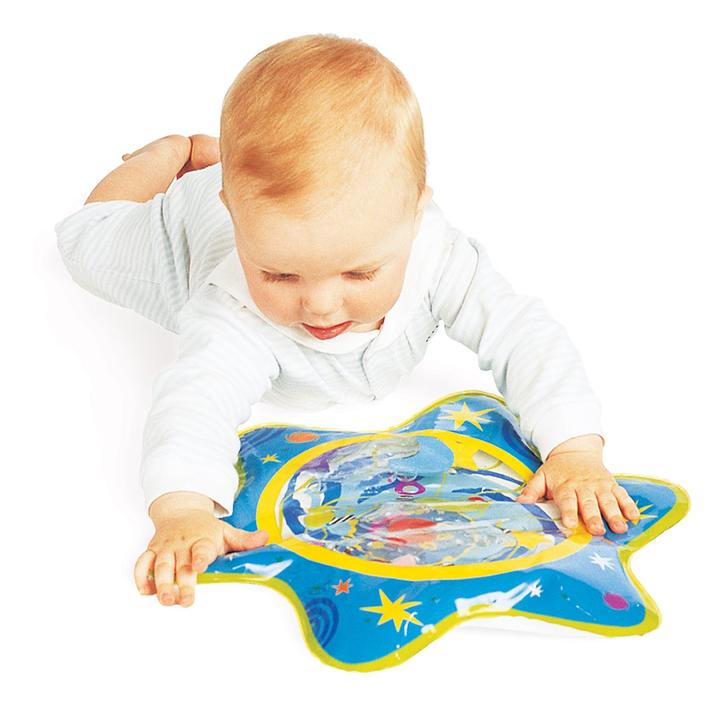8 Reasons Why Your Baby is Fussy – Plus How to Trigger the Calming Reflex

6 minute read
When you give birth, your baby’s cry is a welcome sound that shows that your baby is healthy! But as the days and weeks progress, your little one’s cries can become a source of anxiety, frustration, or even dread.
As a new parent, one of the most difficult challenges is figuring out why your baby is upset. But that’s easier said than done! What exactly is “normal” and what steps can you take to soothe your new babe?
It’s Normal to Have a Fussy Baby
Don’t think of yourself as a bad parent just because your little one cries throughout the day. Crying at this young age is actually a reflex! Your baby is able to cry from their first moment of life because they need to be able to do one thing: get your attention!
Without this crying reflex, your baby wouldn’t be able to tell you what they need. And they would actually be in great danger if they couldn’t call out to you to let you know that they’re hungry, cold, or tired.
How Long Should My Baby be Crying?
While crying is normal for babies, as a new parent, you may start to wonder if your baby is crying too often. You may ask yourself if the amount they’re crying is “normal.”
Every baby cries — usually for 2 to 3 hours a day in the newborn phase (up to 6 weeks). The amount your baby cries usually peaks around the 6 week mark and then begins to decrease. Thankfully, by 3 months, most babies cry for only an hour per day.
But every baby is different! Your baby may cry less or more, depending on their wants and needs.
Why is My Baby Crying?
Although it can be painful as parents to hear your little one cry… Your baby’s cry is very effective because it immediately gets you to respond to their needs. Sometimes it’s easy to figure out what they need, but other times it’s not. Let’s take a look at eight of the most common reasons for crying.
- Hunger: Newborn babies need to eat every few hours — usually 8 to 12 times during a 24 hour period. Crying is a late sign of hunger. Try to look for early signs such as: moving hands to mouth, lip smacking or rooting. This will help you prevent unnecessary tears!
- A dirty or wet diaper: Sitting in a dirty diaper can be cold, uncomfortable, and even cause painful diaper rash. You can expect 6 or more dirty diapers a day. This means you’ll want to check your little one’s diaper frequently throughout the day to help keep them comfortable and dry.
- Tiredness: Tired babies can become fussy! And your newborn may sleep more often than you think — usually 14 to 16 hours a day in spurts of 2 to 3 hours. Make sure to lay them down for a nap when they start showing early signs of fatigue such as rubbing their eyes, pulling on their ears, having difficulty focusing, or closing their fists.
- Gas: As your baby feeds, they may accidentally swallow some air which gets trapped in their belly. You can help them to release this gas by burping your little one after every feeding.
- Wanting a cuddle: Your baby may get lonely and want to be close to you. Hold your baby against your chest and calmly pat their back to reassure them that they’re not alone!
- Being too hot or too cold: Does your baby feel hot and sweaty? Or are they cooler to the touch? Try adding or removing a layer as needed to help them feel more comfortable.
- Boredom: Your baby may just need a change of scenery! Try sitting in a different chair, walking around the house, looking out the window or even going outside. And when your baby is strong enough and has good neck control — using a front-facing baby carrier can be a great way to entertain your little one.
- Overstimulation: Your baby might get overstimulated by exciting activities. Too much noise, movement, or visual stimulation can make your baby cry. If your baby is getting upset from all the hustle and bustle, try:
- Taking your baby to the place where they usually sleep
- Putting toys away
- Talking quietly and soothingly
- Closing curtains and blinds
- Turning overhead lights off – use lamps if you need to
- Playing music quietly or using a familiar sound machine – this will help cut down on background noise.
There may also be times in the day when your baby is fussier than normal. This is often in the late afternoon or early evening. But when your little one starts to cry, it can be hard to nail down what’s upsetting them.
An easy way to start? Check out our simple checklist below.
Crying Baby Checklist
Once your baby’s crying has your attention, you’ll want to run through this quick checklist.
- Is your baby hungry? Feed them.
- Is your baby wet? Change their diaper.
- Is your baby cold (or hot)? Bundle them up or take off a layer.
- Is your baby lonely or bored? Pick them up — give them cuddles or walk around.
- Is your baby overstimulated or overtired? Place them in a calm, quiet environment.
But if you get through this list and your baby is still fussy and crying…that’s where the trouble begins. Babies can often cry for no apparent reason up to 2 hours a day.
That’s where it can be helpful to know how to calm your little one by triggering their calming reflex.
How to Calm a Fussy Baby with the Calming Reflex
You may have seen a parent rock their little one or use the shushing sound to calm their baby when upset. That’s because these sensations — soft touch, jiggly motion, snug holding, etc. — are similar to those your baby experienced in the womb!
Just like going for a car ride or running the vacuum cleaner… Recreating the sensations your baby experienced in utero can trigger a calming reflex that helps soothe your baby in a matter of minutes. But according to Dr. Harvey Karp, this reflex can only be triggered with very specific actions.
To turn on your baby’s calming reflex, you’ll want to imitate five sensations that your baby experienced in the womb.
Let’s take a look.
- The First S: Swaddle
Snugly wrapping your baby in a swaddle will recreate the tight and soothing feeling of the womb. Wrapping your little one’s arms snugly against their sides will prevent the Moro reflex — or startle reflex — which can be caused by their own cry. This is the first step to successfully soothing your baby.
We have some of our favorite beautiful — and useful! — swaddles and swaddle blankets in the Babies in Bloom Boutique.
- The Second S: Lying on the Side or Stomach Position
Holding your baby on their stomach or side will help them calm down in no time. Always be sure to monitor your baby while they’re in these positions and don’t let your baby fall asleep as this could increase their risk of SIDS.
- The Third S: Shush (or Strong White Noise)
Your newborn baby is used to the sound of the womb — which can actually seem as loud as a vacuum cleaner! This loud noise came from the rushing of your blood throughout your body and uterus. You can recreate this environment to help calm your baby by loudly shushing in your baby’s ear. Or, you can use a sound machine with strong white noise.
- The Fourth S: Swing
Your baby will love small, jiggly movements because this is what they were used to in the womb! Think about what your baby would have experienced when you jogged down the stairs or walked around the neighborhood. While supporting your baby’s head and neck, use small motions — no more than one inch back and forth — to quickly rock your baby.
- The Fifth S: Suck
Sucking can really help to calm your baby. Whether your nipple, a clean finger, or pacifier, your baby may even relax into a deep sleep by sucking on something.
Trying to find the perfect pacifier? Take a look at safe, durable — and cute! — pacifiers available in the Babies in Bloom Boutique.
Getting the hang of the 5 S’s can take a little practice. Dr. Harvey Karp, who invented the technique says that “The calming reflex is just like the knee reflex: Hit one inch too high or low, and you’ll get no response, but hit the knee exactly right and, presto!” To see Dr. Karp demonstrate the 5 S’s watch this 3-minute YouTube video.
But if you’ve been through the quick checklist, tried the 5 S’s, and still can’t console your little one, you may start to wonder if it’s more than just fussiness…
Is My Baby Just Fussy? Or Does My Baby Have Colic?
If your baby is crying more frequently, passing the 3-hours a day range, they may have colic.
Colic is often defined by the “rule of three”: crying for more than three hours per day, for more than three days per week, and for longer than three weeks in an infant who is well-fed and otherwise healthy (American Family Physician).
At this point, it’s a good idea to visit your pediatrician to make sure your baby isn’t sick or hurt. They can also provide advice or medication to help comfort your baby.
Getting Help With Your Crying Baby
Staying calm and relaxed will make it easier to soothe your baby. Remember to take breaks, especially if you feel yourself getting tired, frustrated or angry. Anytime you feel like you’re losing control, place your baby in their crib and walk away for 10 minutes. Or reach out to a family member or friend to watch your little one for an hour while you get out of the house.
No matter what, don’t shake your baby while you’re frustrated. This can cause severe damage to your little one. If you’re feeling alone while caring for your baby, you can call a crisis hotline, mental health organization, or your healthcare provider.
It can also be helpful to have a community of parents to lean on for support during this challenging time. Stop by the boutique, attend a new parent group, or attend a class or two to gain support and helpful knowledge along your parenting journey.






